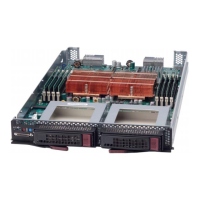
Do you have a question about the Supermicro SBA-7121M-T1 and is the answer not in the manual?
| Brand | Supermicro |
|---|---|
| Model | SBA-7121M-T1 |
| Category | Server Board |
| Language | English |
General description of the blade module and system, including definitions of system terms.
Lists components typically included with the blade module and optional add-on cards.
Details on mainboard, processors, memory capacity, storage, and ports.
Contact information for Supermicro headquarters, Europe, and Asia-Pacific.
Guidelines for safe handling of electrical components and power sources.
Rules for maintaining a safe working environment and handling components.
Measures to prevent damage to electronic components from static electricity.
Important considerations for safe blade module operation and airflow.
Covers the setup and installation of the blade module and its components.
Procedures for installing, removing, and replacing blade modules in the enclosure.
Step-by-step guide for removing and installing processors on the mainboard.
Instructions for replacing the mainboard battery for volatile memory.
Guide on populating memory slots and installing DIMMs correctly.
Procedures for installing and removing hot-swappable hard disk drives.
Methods for OS installation via USB CD-ROM, PXE boot, or Virtual Media.
Overview of system management software packages like IPMIview and IPMItool.
Steps for creating RAID arrays using supported hard drives.
Description of the blade's control panel, buttons, LEDs, and connectors.
Details on the mainboard layout, chipset, jumpers, and CMOS clear procedure.
Overview of main components including memory support and hard disk drives.
Prerequisites and verification steps before configuring RAID.
Modifying BIOS settings to enable RAID functionality.
Using the BIOS utility to select RAID mode and drives.
Introduction to the AMI BIOS Setup utility and how to run it.
Describes the main BIOS menu structure, navigation, and system overview.
Detailed configuration options for system behavior, including boot, CPU, and storage.
Options for prioritizing boot devices and sequences.
Settings for managing BIOS passwords and boot sector virus protection.
Options for saving changes, discarding, or loading default BIOS settings.
Lists and explains BIOS Power-On Self-Test (POST) messages for troubleshooting.
Lists terminal POST codes for AMI BIOS diagnostics.